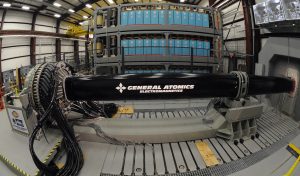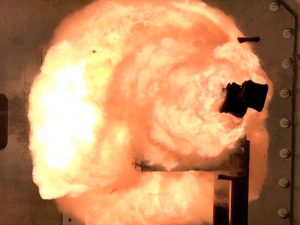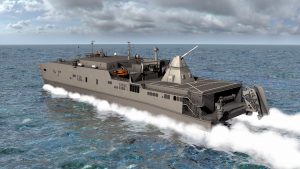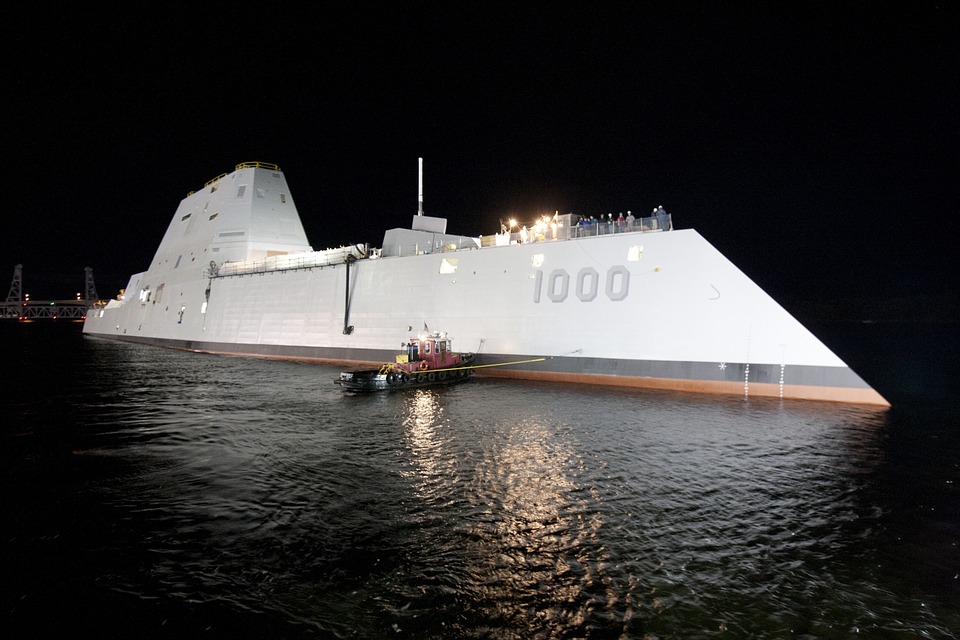De Faakto Intelligence Research Observatory

The Railgun-An Open Source Intelligence Study
Methodology–OSINT research
Background and Analysis
The railgun is a weapons system that uses electromagnetic energy to propel a hard hitting projectile 7 times the speed of sound. Unlike conventional artillery and navel gunnery, gunpowder or explosives are not needed. Railguns use kinetic energy to destroy targets, as opposed to the exploding warheads used by traditional gunnery. The railgun is a safer shipboard weapons system; hundreds of multi use projectiles can be stored without the dangers associated with explosive materials. The railgun is a powerful electrical circuit that requires a massive power source, conductive rails and a moveable bridge armature to hurl the projectile. The projectiles from railguns can be launched at 2.5 kilometres per second, over distances of up to 200 kilometres. This is much farther then the 13 nautical mile range of the U.S. Navy’s standard 5 inch naval gun. The railgun can also be armed with guided shells capable of homing in on targets, and dodging defensive systems. The downside of the railgun is vast amounts of electricity is required. Special equipment is necessary to generate 32 million joules of energy. Exceptional capacitors and batteries are needed to repetitively generate the pulses needed fire the railgun, and special barrels are essential to withstand the stresses associated with launching hypervelocity rounds using magnetic fields. The infrastructure considered necessary for a rail gun means the ship must be specially built around the electrical requirements and retrofitting a navel vessel with the electrical power vital to supply the rail gun is cost prohibitive. U.S. railgun technology is advancing, however the railgun designed and tested by General Atomics & BAE Systems is too large for the navy to field on a ship for sea trials. China is a clear competitor in railgun proficiency and has managed to arm the Type 072III Yuting-class tank-landing ship “Haiyang Shan” with a railgun. Experts are of the opinion that the Chinese technology is not an advanced or readily deployable weapons system. The U.S. railgun is competing with other energy related weapons platforms for priority status within Pentagon budgets. Directed energy weapons and hypervelocity projectiles are emerging as higher priorities over the railgun. Ship Bourne solid state laser technology is rapidly being developed to defend naval assets from drones with explosive payloads and small harassing boats. The U.S. Navy has announced it is planning to outfit the USS Arleigh Burke with a 60-kw Surface Navy Laser Weapon System as part of an integrated missile-and-drone defense system by 2020.

[Official Website of the United States Navy, 2012]
Key Research Points,
What is a Railgun?
- A traditional artillery gun uses an explosive charge to propel a shell which detonates at the target
- A railgun uses electromagnetic energy to launch a projectile at speeds six to seven times the speed of sound, the projectile uses kinetic energy to destroy the target (Business Insider, 2019)
How Does the Railgun Work?
- The railgun functions as an incredibly powerful electric circuit (ABC News, 2019)
The railgun consists of three elements,
- A power source
- Conductive rails
- A moveable bridge — also made out of conductive metals — sitting between the rails housing the projectile-this is known as the armature (ABC News, 2019)
- The rails are made out of conductive metals (such as copper) which are fed with whopping amounts of energy from a generator — one side positive, the other negative — to propel the armature at great speed and distance via magnetic force
- This kind of magnetic force is known as the Lorentz force, where the force is directed perpendicular to the magnetic field (ABC News, 2019)

[Official Website of the United States Navy, 2012]
What are the Advantages of a Railgun?
Electromagnetic railguns have numerous potential advantages over existing shipboard defences,
- Hard hitting destructive kinetic energy
- The railgun can hurl a projectile 7.5 times the speed of sound
- The railgun projectile hits targets faster with great kinetic energy
Range
- Tests have shown that projectiles from railguns can be fired at 2.5 kilometres per second, over distances of up to 200 kilometres. (ABC News, 2019)
- This is much farther then the 13 nautical mile range of the U.S. Navy’s standard 5 inch naval gun [U.S. Office of Naval Research] (CNN, 2019)
- The railgun can be armed with guided shells capable of homing in on targets, and dodging defensive systems (NEWS.com.au, 2019)
- Railguns are incredibly fast, and — depending on calculations — the shot can be incredibly precise
Cost effective
- They cost much less per shot than missiles
Safety
- They enhance on-board ship safety (no gunpowder or explosive is present in the projectile)
Logistics
- They reduce logistical requirements
- Hundreds of rounds can be stored on a warship, and they can be applied to multiple missions beyond ship defense (Forbes, 2017)
- Proponents of the railguns praise it for a number of reasons: It makes ships safer as you don’t have to carry explosive ammunition, it’s incredibly fast, and — depending on calculations — the shot can be incredibly precise

[Official Website of the United States Navy, 2012]
What are the Disadvantages of a Railgun?
Massive amounts of electricity are required,
- “The science is pretty straightforward, but the issue is that the railgun calls for huge energy generation, and of course, power is pretty scant at sea, according to ” Dr Jai Galliott, of New South Wales’s School of Engineering and Information Technology at the Australian Defence Force Academy (ABC News, 2019)
- The railgun currently being tested by the U.S. Navy was built by General Atomics and BAE Systems; it has a muzzle velocity of 32 mega joules
- 32 mega joules — 32 million joules — is a lot of electricity
- Special capacitors and batteries are required to repetitively generate the required pulses (Forbes, 2017)
- Railguns need special barrels that can repeatedly withstand the stresses associated with launching hypervelocity rounds using powerful magnetic fields (Forbes, 2017)
- The sheer amount of power that a railgun uses generates incredible heat during operation, and previous US railgun tests have seen rails melt during launches (ABC News, 2019)
- The electrical infrastructure needed for a rail gun means the ship must be specially built around the electrical requirements
- Retrofitting a navel vessel with the electrical power needed to supply the rail gun is cost prohibitive
Who is Developing Railgun Technology?
- The US is not the only country chasing this technology
China

- Another clear competitor is China, which has already managed to arm a warship — the Type 072III Yuting-class tank-landing ship “Haiyang Shan” — with a railgun
- The weapon is believed to have been put through some preliminary sea trials (Business Insider, 2019)
- The Type 072II Yuting-class tank landing ship Haiyangshan has been converted from its previous role to become an experimental test bed
- This is likely because its open cargo bay is capable of holding the extensive array of batteries and generators necessary to power the next-generation weapon
- While the Type 072II Yuting-class tank landing ship is still no warship, the cannon it carries is a fearsome sign of things to come (NEWS.com.au, 2019)
Is The Railgun All It Is Chalked Up To Be?
- A Chinese senior editor from a prominent defence publication told ABC anonymously that the wide scale threat of Chinese railguns is not on the horizons
- As we have seen, the US electromagnetic railgun is so big that it’s unable to be carried by a warship (ABC News, 2019)
- At present, it is unclear if China’s railgun is able to fire multiple rounds, at what rate per minute it can fire, and what exactly they are going to do with the gun
- Dr Jai Galliott, of New South Wales’s School of Engineering and Information Technology at the Australian Defence Force Academy believes it is all a bit of a fizzer (ABC News, 2019)
- “The thing with Chinese technology is that it might look like something on the outside but actually be hollow on the inside,” says Dr Galliott
- “From what I’ve seen it doesn’t look like anything special, and it doesn’t look like it would be a readily deployable weapon — it might be more for PR purposes than anything else.” (ABC News, 2019)
Is The Railgun Competing With Other Emerging Technologies?
- The Pentagon is developing other technologies and the railgun is just one of several future weapons
- The Pentagon’s portfolio of directed energy projects, like solid-state lasers and the hypervelocity projectile, both have emerged as higher priorities than the railgun (National Interest, 2019)
- Popular Mechanics points out that recent breakthroughs with conventional solid-state laser weapons have induced the Navy to propose $300 million to rapidly develop and equip ship borne laser weapons to fend off explosive-laden drones and small boats that could harass smaller Navy warships
- The service recently announced that it planned on outfitting guided-missile destroyer USS Arleigh Burke with a 60-kw Surface Navy Laser Weapon System as part of an integrated missile-and-drone defense system by 2020

Resources
Why China’s ‘miracle’ railgun weapon should scare the U.S. navy-Global News- Josh K. Elliott (2019) https://globalnews.ca/news/4810853/china-railgun-warship-weapon/
US Navy’s Railgun Entering New Testing Phases-The Diplomat- Steven Stashwick (2019) https://thediplomat.com/2019/06/us-navys-railgun-entering-new-testing-phases/
The US Navy is talking about finally taking its railgun out to sea for testing aboard a warship-Business Insider- Ryan Pickrell (2019) https://www.businessinsider.com/us-navy-talking-about-finally-testing-railgun-at-sea-2019-5
What exactly is a railgun, and do we need to start building bunkers again? ABC News- Alan Weedon (2019) https://www.abc.net.au/news/2019-01-03/the-railgun-explained-and-what-it-means-for-us-china-relations/10683526
A U.S. Navy Railgun: A Dying Dream? The National Interest & Task & Purpose- Jared Keller (2019) https://nationalinterest.org/blog/buzz/us-navy-railgun-dying-dream-43217
Navy’s Hypervelocity Railgun Could Be A Gamechanger — If Congress Funds It-Forbes –Loren Thompson (2017) https://www.forbes.com/sites/lorenthompson/2017/07/19/navys-hypervelocity-railgun-could-be-a-gamechanger-if-congress-funds-it/#1578abb94550
China closer to equipping warships with electromagnetic railguns, state media reports-CNN- Euan McKirdy (2019) https://www.cnn.com/2019/01/04/asia/china-pla-navy-railgun-intl/index.html
China’s world first: Electromagnetic railgun goes to sea-NEWS.com.au – Jamie Seidel (2019) https://www.news.com.au/technology/innovation/military/chinas-world-first-electromagnetic-railgun-goes-to-sea/news-story/6e31d167e88308f59ec96332ef1e867b
Navy Evaluating Second Electromagnetic Railgun Prototype-U.S. Government- Official Website of the United States Navy (2012) https://www.navy.mil/view_imagex.asp?id=135294&t=1
Navy to Deploy Electromagnetic Railgun Aboard JHSV- U.S. Government- Official Website of the United States Navy (2012) https://www.navy.mil/submit/display.asp?story_id=86987
With a Bang, Navy Begins Tests on EM Railgun Prototype Launcher- Official Website of the United States Navy (2012) https://www.navy.mil/submit/display.asp?story_id=70058






